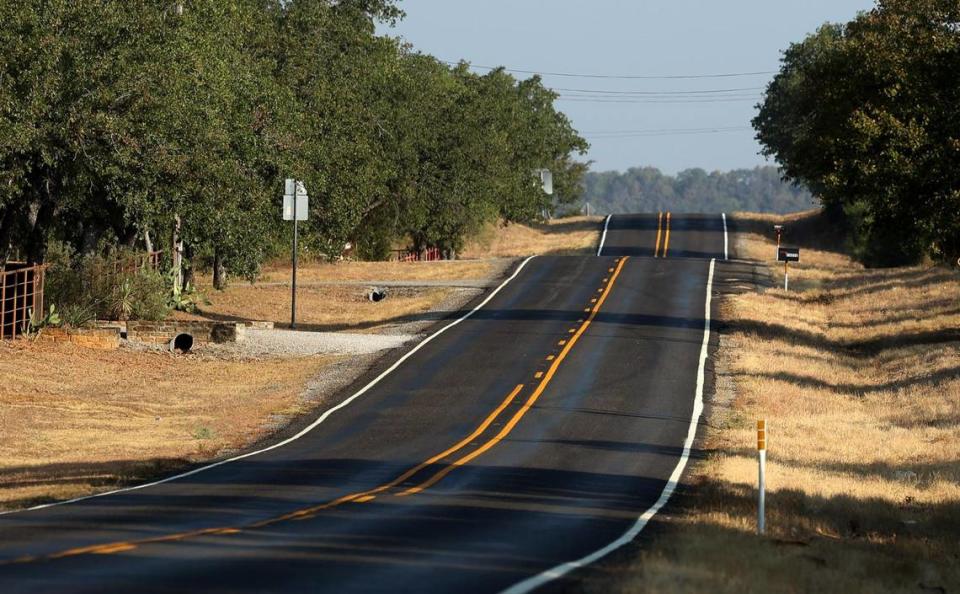‘We are at Dangerous Levels.’ Water restrictions take hold as North Texas reservoirs dry up
When Rhome Mayor Patricia Mitchell looks at her yard and others’ throughout the growing city of almost 2,000 people, she sees parched grass and trees that are losing their leaves.
Rhome’s parks are also drying up: flowers aren’t growing in the butterfly garden and shrubs are dying.
The city has restricted water use since June 29. People can’t fill pools, put in new landscapes or water their yards. Even a city celebration was canceled.
The city’s water supplier, the Walnut Creek Special Utility District, hopes to cut use by 30% to have enough water on hand for essential uses such as bathing and for drinking.
Other communities are also cutting back across drought-stricken North Texas, where rainfall is about 10 inches below normal.
Community Water Supply Corp., which supplies 3,750 people in the Azle area, has warned customers to use as little water as possible to avoid running out.
“We are at Dangerous Levels,” an alert reads on its website.
A person who answered the phone at Community Water Supply declined to comment on the current state of the water supply, referring all questions to the general manager who is out until Wednesday.
Mineral Wells has banned outdoor watering, and it might have to bring its reverse osmosis unit online to pull water from the Brazos River if conditions worsen. They city gets its water from Lake Palo Pinto, which is at 35% capacity.
In Santo, 23 miles southwest of Mineral Wells, outdoor watering is also off-limits. Jules Austen puts buckets in her shower and saves the water from her laundry in an effort to save her dying yard.
“Water is the new oil,” she said.

Outdoor irrigation can account for 50% to 80% of water use, according to Mark Wentzel, a hydrologist with the Texas Water Development Board. He said he expects the drought conditions to continue for the next month before the El Niño weather pattern brings cooler and wetter weather during the fall and winter.
“There are some real positive signs. We should start seeing cooler temperatures,” he said.
Until then, he urged conservation.
Rhome ‘diligent’ about reducing water use
Mitchell, Rhome’s mayor, believes people have gotten the message.
“I see lots of brown yards out here, so I think almost everyone is complying with the restrictions,” she said.
The Walnut Creek Special Utility District serves 33,000 customers in Wise and Parker counties. Rhome’s water comes from Lake Bridgeport and several wells.
On Thursday, Lake Bridgeport was 65% full.
“Most will say that 65% full is a good thing, but when you hit 45% empty, you are in a gray area,” said James Blackwood, general manager for the Walnut Creek Special Utility District.
Walnut Creek uses around 6 million gallons of water a day, but restrictions have saved about 2 million a day, Blackwood said.
The district is updating its system to meet growing demand, he said. Construction on one of the region’s largest housing developments is underway just outside Rhome, near U.S. 287 and Texas 114.
Amanda DeGan, Rhome’s city administrator, said the restrictions have affected community events. An anniversary celebration for the library was canceled because plans included water slides.
“We’ve been diligent. We’ve been getting through this as a community. Everyone’s doing a really good job of conserving,” she said.
Mineral Wells, Santo water source at 35%
Mineral Wells City Manager Dean Sullivan said the lack of rain, record high temperatures and the increasing population have strained the city’s system. He said the city will consider financing a reservoir to meet the demand.
“The concerns should be obvious to everyone, we must all do what we can to preserve our water resource until the rain returns,” Sullivan wrote in an email to the Star-Telegram.
Nearby Santo gets its water from the Santo Special Utility District, which purchases water from Mineral Wells.
Austen, who has been saving water for her yard, moved from Fort Worth to help take care of her mother and for the peace and quiet of country life.
She said she worries about more people moving to the area and what that means for the water supply.
“We really take things for granted until they are gone,” she said. “People say global warming is baloney, but here it is.”
Rhea Gilbert-Watts and her family own the Gilbert Pecan Company in Santo. Her family’s roots in the area date to 1857. They are no strangers to droughts.
Gilbert-Watts said the drought hasn’t affected the business because the company gets pecans from other sources in Texas. The native pecan groves can withstand the drought with good rains in the spring and in October, when the pecans are harvested.
Yet she is concerned about the growing water shortage and how that affects her friends who are farmers and ranchers.
“We are lifelong residents. We have our home out here. It’s a concern because the water restrictions were implemented sooner than in 2011,” she said, referring to the driest year in Texas. “It’s helped prolong the longevity of our lakes, but we’re not out of the woods yet.”

